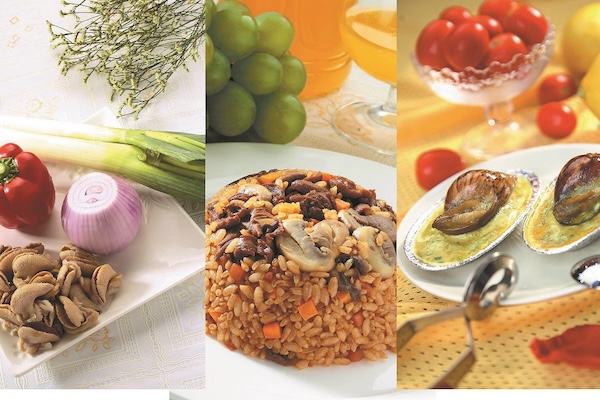Snails bring wealth of benefits to villagers

From left: Snails with other ingredients for a dish; snails fried with rice; baked snails. CHINA DAILY
Turning point
Although farmers in Jiaxing started to breed snails back in 1987, market demand was small and unsteady, with only a few restaurants placing orders. As a result, the industry grew at snail's pace.
"The overall income of rural households in those days was not high," Huang said.
The turning point came when Shen Fuliang, a farmer in Daqiao, was considering selling snails online in 1999, after being inspired by technology giant Alibaba, which had just been founded in Hangzhou, capital of Zhejiang.
Despite facing a huge initial investment and skepticism from friends and family, Shen decided to put his idea to the test.
"I thought it was better to try and fail, rather than envy others' success," he said.
After several attempts, Shen launched a website to sell snails in May 2000. However, just when his hopes were falling after two months without any business, the first order arrived, giving him the confidence to persist in his new venture.
"I had faith that as more people became acquainted with the internet, this would open up new opportunities online," he said.
Just a year later, Shen was inundated with orders for snails from across the country.
Seeing his success, local snail farmers also launched online businesses to meet the surging demand.
In 2000, Shen founded the snail breeding cooperative with local government support, but the expanding market soon brought new problems.
Long-distance transportation to cities such as Beijing and Guangzhou, capital of Guangdong province, led to a significant loss of live snails, despite the adoption of protective measures such as using ice cubes in summer and foam boxes for insulation in winter.
To address the issue, Shen considered removing the snails' shells and internal organs to produce semifinished products for cold storage, an ambition he finally realized in 2003.
"This way, the shelf life of snails is extended from just a few days to 18 months, significantly prolonging the sales cycle and reducing transportation costs," he said.
In 2005, Jiaxing Qianfu Food Co took part in drawing up provincial snail breeding standards, which have resulted in rigorous supervision and consistent production levels.
The company now operates a snail industry chain, which features a breeding demonstration farm, a laboratory for quality checks, and washing, shelling and cooking facilities.
Humid conditions
Visitors to the company's snail breeding farm are greeted by a blast of humid air.
Chen Zepeng, Shen's son, who helps run the snail business, said, "The temperature has to be maintained at about 28 C and the humidity level at above 80 percent."
Some 120-150 snails are kept in a single breeding box with a layer of soil at the base. There are hundreds of such boxes at the farm.
"Each box is cleaned every seven to 10 days and the soil is replaced, because the snails will stop feeding if their living conditions are dirty," Chen said.
Pulverized lime is sprinkled as a calcium supplement over the fresh soil in the breeding boxes, before fresh vegetables and other food is put in.
"The final step is to spray the boxes with water to increase the humidity and enhance the smell of the snails' food," Chen said.
After growing for four to five months, white jade snails will weigh 35-40 grams, and are ready for use.
Snails from the demonstration farm and rural households are then randomly selected and sent to the laboratory to test for substances such as antibiotics.
Next, the snails are placed in an automated washer before going to the shelling room, where a dozen employees wearing laboratory coats, hairnets, gloves and face masks adeptly perform this procedure.
"We have to shell the snails by hand, as every shell has an irregular shape," Chen said, adding that automatic arms were used as an experiment for this procedure, but they often broke the shells, leaving shards in the meat.
The meat then undergoes a second round of fine-trimming to ensure it is thoroughly cleaned.
"These manual steps require more than 50 villagers, who have been with us for a long time and are highly proficient in their work, which gives them extra income," Chen said. The workers handle 50,000 kg of snails a day.
The snail meat finally goes to a central kitchen, where it is cut into different shapes and sizes as required by customers, and prepared into premade dishes with various ingredients.
At the central kitchen, Feng Limin, director of the company's precision processing workshop, said, "Our products have evolved from simple semifinished goods to gradually include eight premade dishes."
Before joining the company in 2006, Feng worked as a restaurant chef.
"I'm glad I made the right decision," he said, adding that he has seen firsthand over the years how snail breeding and processing standards have continued to improve.
"Everyone at the company believes that happiness doesn't come to them on its own--it's achieved through hard work and perseverance," Feng added.


 Red boat spirit inspires new developments
Red boat spirit inspires new developments Zhejiang: A Decade of Progress
Zhejiang: A Decade of Progress A look at Jiaxing's H1 economic data
A look at Jiaxing's H1 economic data